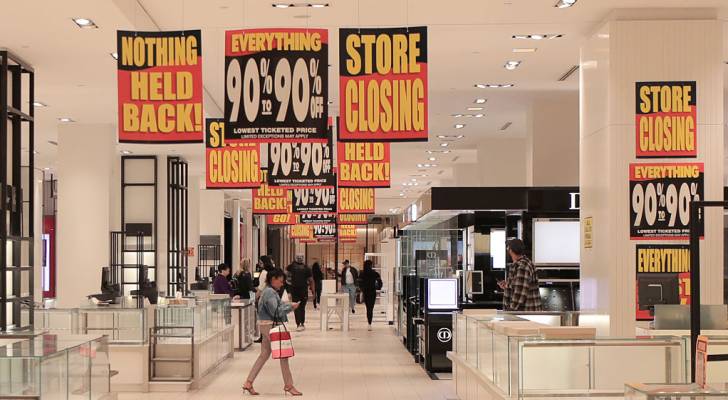
For 355 years, Hudson’s Bay Company was more than just a business. It was a living thread in the fabric of Canadian identity. But in July 2025, that thread was abruptly cut. Poor leadership, outdated strategies and a failure to adapt to modern retail realities led to the collapse of one of the country’s most iconic institutions.
Once a pioneer of commerce and culture, HBC officially closed its doors after filing for creditor protection in March. By June, liquidation was underway. By mid-July, the last stores had shut down, marking the end of an era that once seemed unbreakable.
For many Canadians, the closure isn’t just about lost retail outlets. It’s the bittersweet loss of a cornerstone of Canadian culture, and a cautionary tale about what happens when tradition resists transformation.
A proud legacy built on Canada’s frontier spirit
HBC’s roots run deep in Canadian soil. Beginning as a fur trading company that helped shape the country’s early economy and geography, it played a vital role in Canada’s westward expansion and was a trusted presence in both Indigenous and settler communities. Over centuries, it evolved, first into a retail powerhouse, then into a cultural symbol.
By the 20th century, Hudson’s Bay had become the country’s leading department store, known for blending commerce with community. Its iconic striped blankets — now symbols of heritage — reflected a brand built on tradition, trust and continuity.
But as the Toronto Star’s reporting shows, that legacy became a burden under the leadership of Richard Baker. While the brand represented resilience and adaptation, Baker’s tenure came to symbolize resistance to necessary change. HBC’s proud history, ironically, became one of its greatest vulnerabilities.
Leadership failures and a brand outpaced by change
The Star’s investigation, based on interviews with former senior executives, makes one thing clear: HBC’s collapse was not a foregone conclusion. It was, in large part, a failure of leadership.
At the centre of that failure was Richard Baker, the real estate magnate and executive chairman who took majority control of HBC in 2008. According to insiders, Baker prioritized real estate value and short-term financial maneuvering over the hard — and costly — work of retail reinvention. While competitors like Walmart and Amazon were reshaping the shopping experience through logistics, tech and data, HBC remained tethered to a mid-century department store model.
Instead of investing in digital infrastructure, store modernization or merchandising strategy, Baker focused on extracting value from HBC’s property portfolio. One executive described him to The Star as “a landlord first, a retailer second” — a fatal stance in an era when foot traffic was declining, e-commerce was surging and customers expected innovation.
The result? Missed opportunities, strategic paralysis and an erosion of customer loyalty, especially among younger Canadians. While rivals adapted to shifting consumer behavior, HBC’s leadership watched from the sidelines.
Financial collapse marks the end of an era
By early 2025, the consequences of this inertia came crashing down. With more than $1.1 billion in liabilities and no meaningful recovery plan, HBC filed for creditor protection under the Companies’ Creditors Arrangement Act. Attempts at restructuring fell flat, which proved to be the final chapter in what former employees saw as years of squandered potential.
The company’s slow fade wasn’t just about macroeconomic forces or the rise of online retail. As The Star reported, insiders believe that with bolder, retail-focused leadership, HBC could have survived. Instead, the company that once helped define Canada folded under the weight of poor decisions, missed trends and misplaced priorities.
For many Canadians, HBC closing its doors was a loss of a national symbol. But for those inside the company, it was also a story of deep frustration: a legacy lost not to time, but to mismanagement.
A new chapter for HBC’s iconic brand
In a move that offers a glimmer of hope, Canadian Tire Corporation stepped in to acquire HBC’s valuable intellectual property, including the beloved stripes and coat of arms, for $30 million.
Greg Hicks, Canadian Tire’s CEO, called the purchase “strategic” and “patriotic,” emphasizing a commitment to safeguarding a treasured part of Canada’s heritage. While the leadership behind HBC failed to modernize its operations, Canadian Tire aims to preserve what still resonates — by weaving these iconic symbols into its existing brands like Mark’s and SportChek. In doing so, the company hopes to keep the legacy alive, even if the institution itself could not survive mismanagement.
The emotional impact on Canadians
For many Canadians, HBC was a thread connecting their past, family memories and national identity. Its closure has left a palpable emotional void across the country.
At a liquidating store in Edmonton, shopper Susan Carpenter reflected on the decades‑long connection her family had with the brand. “It’s a crying shame… It still, to me, is a big deal,” she said, recalling that her grandmother once worked at a Bay store and that she herself spent holiday seasons on its sales floor .
Retail expert Amelia Fay, curator of the HBC collection at the Manitoba Museum, described the company as “hugely important to what we now call Canada,” noting that the stripes and blankets “have become a symbol of the company and Canada.”
Still, a national Leger survey revealed that emotional responses were mixed: while 83% of Canadians were aware of HBC’s bankruptcy filing, only 25% said they felt sadness. Another 30% reported indifference, particularly among younger Canadians under 55 — many of whom never connected with the brand in its final years.
That disconnect speaks to the deeper consequences of HBC’s leadership failures. While the emotional legacy remained strong for some, the company’s inability to engage a new generation, or evolve its relevance, left others behind. HBC’s final chapter is both nostalgic and instructive, and a reminder that cultural legacy must be actively maintained, not assumed.
What Canadians can learn from HBC’s fall
HBC’s demise offers crucial lessons for Canadian businesses and consumers alike. No matter how historic or beloved, companies must embrace innovation and adapt quickly or risk fading away.
The Star’s reporting underscores that heritage alone isn’t enough — especially when decision-makers prioritize asset value over brand evolution. For investors and shoppers, HBC’s story is a case study in the danger of short-term thinking and the cost of underestimating change.
It also highlights how retail is evolving, pushing Canadians to rethink how they engage with brands and support businesses that balance tradition with forward-thinking strategies.
Looking ahead: preserving Canadian heritage in a new era
Though HBC’s physical stores have closed, the acquisition by Canadian Tire promises a new form of legacy, and one that honors the past while looking toward the future.
At a time when Canadians are navigating economic uncertainty and rapid change, the story of Hudson’s Bay Company reminds us that preserving national identity isn’t just about symbolism. It requires stewardship, vision and the willingness to evolve.
HBC’s stripes may no longer hang in storefronts, but they remain woven into the cultural fabric and a symbol of resilience, but also a cautionary tale. The future of Canadian heritage will depend on how well the next generation of leaders learns from the ones who let it slip away.
Sources
1. The Star: Inside the death of Hudson’s Bay: Why former senior employees believe leader Richard Baker should take the blame (July 22, 2025)
2. Global News: Amid empty shelves and idle escalators, shoppers seek piece of history at Bay stores (March 17, 2025)
3. Canadian Affairs: Hudson’s Bay Company: from fur trade to department store downfall (March 31, 2025)
4. Retail Insider: Mixed Feelings as Canadians React to Hudson’s Bay Bankruptcy (March 28, 2025)
This article provides information only and should not be construed as advice. It is provided without warranty of any kind.


